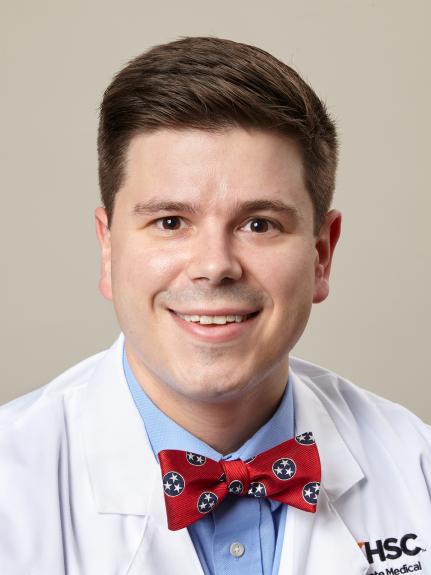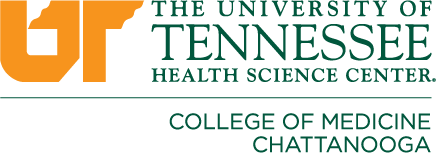Supervision and Procedures: Thompson, Roger (DO)
The Residency Supervision Area is designed to assist hospitals and clinics with the protocols outlined for specific duties residents and fellows can perform. These guidelines are determined by the faculty of the University of Tennessee College of Medicine Chattanooga, Cardiovascular Disease Fellowship. Any questions about certain procedures not listed should be addressed to the faculty and not decided by the resident or fellow.
A credentialed and privileged attending physician ultimately provides supervision or oversight of each Resident's patient care activities. Direct supervision by a qualified attending physician (or a more senior Resident with Indirect Supervision immediately available) is required in the OR/Delivery Room or for non-routine invasive procedures like Cardiac Cath, Endoscopy, and Interventional Radiology.
- Click here to view our UTCOMC GME Policy 400 Resident Supervision
- Click here to view the UTCOMC GME Policy 405 Patient Care Settings Resident Supervision Standards

Roger Thompson, DO
PGY-5 (2nd Year) Fellow
Cardiovascular Disease
Resident Supervision will consist of four categories/levels:
- Direct Supervision - the supervising physician is physically present with the resident and patient.
- Indirect Supervision with Direct Supervision IMMEDIATELY available - the supervising physician is physically within the hospital or other sites of patient care, and is IMMEDIATELY available to provide Direct Supervision.
- Indirect Supervision with Direct Supervision available - the supervising physician is not physically present within the hospital or other sites of patient care, but is IMMEDIATELY available by means of telephone or other electronic means, and can be available if required for Direct Supervision
- Oversight - Supervising Physician is available to provide a review of procedures or the encounter with feedback after the care is provided but the procedure or care does not warrant the physical presence of the attending.
- In particular, PGY-1 residents should be supervised either directly or indirectly with direct supervision immediately available as described in the levels of supervision, unless denoted as Oversight in the list that follows.
- In an emergency, defined as a situation where immediate care is necessary to preserve life or prevent serious impairment, residents are permitted to initiate whatever care is necessary and reasonable to save a patient from serious harm even if an attending physician is not immediately available to supervise. The appropriate Medical Staff member should be notified as soon as possible.
- Supervising physicians may be more advanced residents or fellows.
| Certifications current when the resident/fellow entered training at the UTCOMC. |
| Basic Life Support (BLS) |
| Advanced Cardiac Life Support (ACLS) |
As a 2nd Year Fellow in the Cardiovascular Disease Fellowship, the Fellow can perform any Cardiology or Internal Medicine physician skill or procedure deemed appropriate by his/her attending physician or specialty physician skill or procedure deemed by an attending physician in a department in which the Resident is assigned for rotation (e.g., Emergency Medicine, Critical Care, etc.). Cardiovascular Disease Fellows have completed an Internal Medicine Residency and are able to perform appropriate Internal Medicine procedures without supervision as credentialed by the hospital's Medical Staff rules and regulations. Regarding Cardiovascular Disease procedures, Fellows areexpected to progressively assume more responsibility throughout each level of training and demonstrate competence in skills/procedures requiring less Direct Supervision. The supervising physician may make adjustments in the level of supervision required for that specific procedure.
Patient Care Skills or Procedures that do not require Direct or Indirect Supervision presence of a supervising physician (i.e., Oversight/General Supervision) are listed below. Anything not specifically listed requires either Direct Supervision, Indirect Supervision with Direct Supervision Immediately Available, or Indirect Supervision with Direct Supervision available by phone or other electronic media, at the discretion of the supervising physician.
| PGY-4, PGY-5, and PGY-6 Cardiovascular Disease fellows can perform the procedures listed below with Indirect Supervision: |
| PGY-4 Cardiovascular Disease Fellows can perform the procedures under Indirect Supervision or Oversight highlighted in blue. |
| PGY-5 Cardiovasular Disease Fellows can perform the procedures under Indirect Supervision or Oversight highlighted in orange. |
| PGY-6 Cardiovascular Disease Fellows can perform the procedures under Indirect Supervision or Oversight highlighted in grey. |
| Differential Diagnosis, Treatment, and Patient Care Skills | PGY-4 (1st Year) |
PGY-5 (2nd Year) |
PGY-6 (3rd Year) |
| Perform all Internal Medicine related procedures since they are already eligible for the Internal Medicine Boards or are already ABIM certified. | X | X | X |
| Cardiology consults in the Emergency Department | X | X | X |
| Clinical and Social History | X | X | X |
| Communicate with patients and family members | X | X | X |
| EKG - perform and interpret | X | X | X |
| Formulate diagnostic and treatment plans | X | X | X |
| Formulate pre-and post-operative treatment plans | X | X | X |
| Interpret basic x-rays and imaging studies | X | X | X |
| Interpret laboratory and diagnostic studies and tests | X | X | X |
| Mark diagnostic procedures on patients | X | X | X |
| Order radiologic, laboratory, or other diagnostic tests | X | X | X |
| Participate in and run a code (adults) | X | X | X |
| Request specialty and subspecialty consults | X | X | X |
| See patients and write patient orders | X | X | X |
| Supervise Medical Students, Residents, and more junior Cardiovascular Fellows |
X | X | X |
| Physical Examination | X | X | X |
| Write admission, treatment orders, and notes in the Electronic Health Record |
X | X | X |
| Cardiopulmonary Resuscitation and Airway Maintenance | |||
|
Perform Basic CPR and related procedures (airway management, emergency drug therapy, rhythm strip interpretation, intravenous catheterization, closed chest massage, adult resuscitation, electrocardioversion & defibrillation, and venous cut-down) |
X | X | X |
| Adult Resuscitation | X | X | X |
| Pediatric Resuscitation | X | X | X |
| Insertion of Oral Pharyngeal Airway | X | X | X |
| Endotracheal Intubation | X | X | X |
| Cricothyroidoctomy | X | X | X |
| Use of Mechanical Respirators | X | X | X |
| Additional Specific Skills | |||
| Arterial puncture for Arterial Blood Gas Collection | X | X | X |
| Interpret Arterial Blood Gases | X | X | X |
| Arthrocentesis | X | X | X |
| Echocardiography | X | X | X |
| Exercise stress testing | X | X | X |
| Interpret ambulatory ECG recordings | X | X | X |
| Interpret electrocardiograms | X | X | X |
| Interpret nuclear cardiology studies | X | X | X |
| Intravenous catheterization | X | X | X |
| Joint Injection | X | X | X |
| Lumbar Puncture | X | X | X |
| Thoracentesis | X | X | X |
| Nasotracheal or orotracheal intubation | X | X | X |
| Paracentesis | X | X | X |
| Perform bladder catheterrization | X | X | X |
| Pulmonary catheter insertion | X | X | X |
| NG Tube Placement | X | X | X |
| Participate in and supervise medical critical care patients | X | X | X |
| Splinting of Fractures & Dislocations | X | X | X |
| Supervise residents assigned to Cardiology | X | X | X |
| Supervise an Inpatient Cardiology Team | X | X | X |
| Sutures | X | X | X |
| Venipuncture | X | X | X |
| Emergency Use of External Temporary Pacemakers | X | X | X |
| Emergency Treatment of 1st, 2nd, & 3rd Degree Burns | X | X | X |
| Diagnostic Peritoneal Lavage | X | X | X |
| All other procedures are performed under direct supervision of a faculty member or more senior fellow. |


